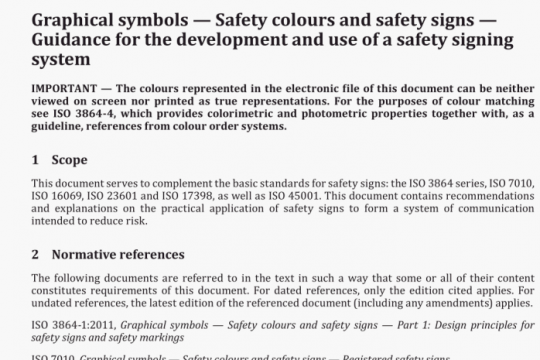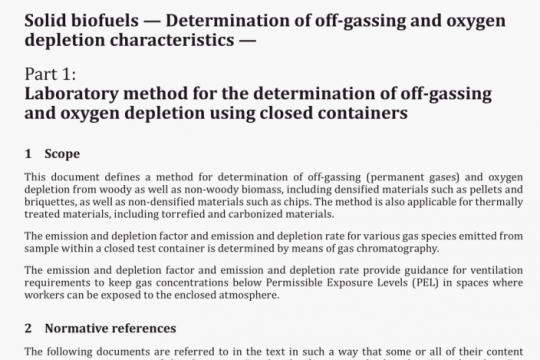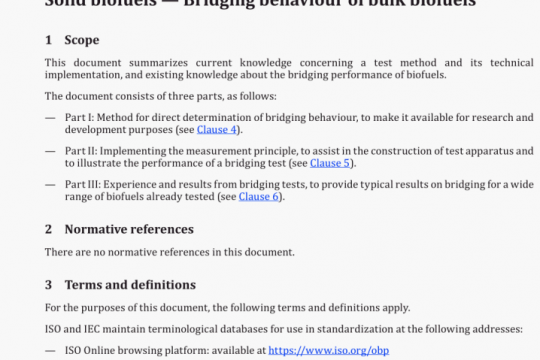ISO 75-1 pdf free download
ISO 75-1-2020 pdf free download.Plastics – Determination of temperature of deflection under load – Part 1: General l test method.
The heating rate shall be verified periodically either by
— checking the automatic temperature reading, or
— manually checking the temperature at least every 6 mm.
The requirement for the heating rate shall be considered satisfied if, over every 6 mm interval during the test, the temperature change is (12 ± 1) °C.
NOTE I The apparatus can be designed to stop heating automatically when the standard deflection has been reached.
NOTE 2 Liquid paraffin, transformer oil, glycerol and silicone oils are suitable liquids, but others can be used. For fluidized beds, aluminium oxide powder has been found suitable.
5.3 Weights
A set of weights shall be provided so that the test specimen can be loaded to the required flexural stress, calculated as specified in 8.1.
5.4 Temperature-measuring instrument
Use a suitable temperature-measuring instrument of appropriate range and maximum error limit of ±1 °C.
Temperature-measuring instruments shall be calibrated at the depth of immersion particular to the apparatus in use. The temperature-sensing part of the instrument shall be located not farther than 12,5 mm from the point where the loading edge contacts the specimen. The temperature-sensing part of the instrument shall not touch the specimen or be in contact with any part of the frame.
Thermocouples shall comply with the requirements of IEC 60584-1. Resistance thermometers shall comply with the requirements of IEC 60751.
It is recommended that the heating bath is equipped with a separate temperature-measuring instrument at each test station, if there are several.
5.5 Deflection-measuring instrument
Use a calibrated dial gauge or any other indicating or recording device, including electric displacement sensing apparatus, to measure the deflection of the specimen at the point where the loading edge contacts the specimen. The deflection measuring device shall be readable to 0,01 mm.
In certain types of apparatus. the force, F5, exerted by the dial gauge spring acts upwards and therefore reduces the downward force exerted by the weighted rod, while in other types, F5 acts downwards and augments those exerted by the weighted rod. In such cases, it is necessary to determine the magnitude and direction of F so as to be able to compensate for it as specified in &L Since, in certain dial gauges, F5 varies considerably over the measurement range of the instrument, it shall be measured in that part of the range in which the instrument is to be used.
5.6 Micrometers and gauges
These are used to measure the width and thickness of the test specimens. They shall be accurate to 0,01 mm and conform to ISO 16012.
6 Test specimens
6.1 General
All test specimens shall be free of warpage. Due to differences in the cooling conditions for moulded specimens or any asymmetry in structure, for instance, the test specimens may warp during heating, i.e. bend without a load. This shall be checked by loading two test specimens on opposite surfaces.
6.2 Shape and dimensions
Each test specimen shall be a bar of rectangular cross-section (length I> width b > thickness ii). The dimensions of the test specimens shall be as specified in ISO 75-2 or ISO 75-3.
In each test specimen, the thickness and width over the central one third of the length shall nowhere deviate by more than 2 % from the mean value.
Test specimens shall be produced as described in ISO 75-2 or ISO 75-3.
6.3 Specimen inspection
Specimens shall be free of twist and shall have mutually perpendicular adjacent surfaces. All surfaces and edges shall be free from scratches, pits, sink marks and flash.
NOTE Injection moulded test specimens usually have draft angles of between 1° to 20 to facilitate demoulding. Therefore, side faces in moulded test specimens will generally not be parallel. Injection moulded test specimens are never absolutely free of sink marks. Due to differences in the cooling history, generally, the thickness in the centre of the specimen is smaller than at the edge.
Ensure that all cut surfaces are as smooth as possible, and that any unavoidable machining marks are in the lengthwise direction.
The specimens shall be checked for conformity with these requirements by visual observation against straight edges, squares and flat plates, and by measuring with micrometer calipers.
Specimens showing measurable or observable departure from one or more of these requirements shall be rejected or machined to proper size and shape before testing.
6.4 Number of test specimens
Test at least two test specimens. To compensate for warpage effects, the specimens shall be tested pairwise with opposite sides facing the loading edge. If repeated tests are necessary (specified in ISO 75-2 and ISO 75-3), an additional two test specimens will he required for each repeat test.ISO 75-1 pdf download.




